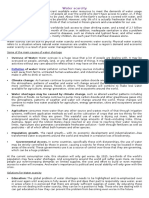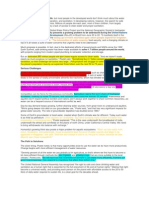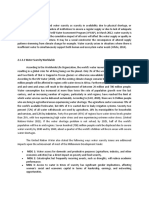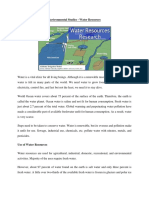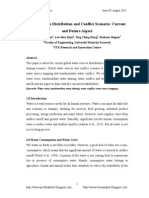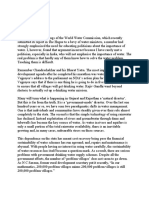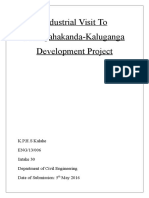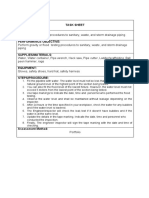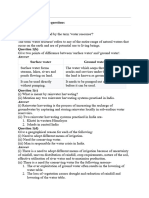0 ratings0% found this document useful (0 votes)
10 viewsПроблема глобального дефицита воды (en)
Проблема глобального дефицита воды (en)
Uploaded by
tuleshova.aruzhanThe document discusses the growing problem of global water scarcity due to factors like urbanization, agriculture and population growth. It notes that over 2 billion people currently live in areas with severe water scarcity and this problem is exacerbated by climate change. Many regions are already experiencing critical shortages including India, Mexico, parts of Africa and the Middle East.
Copyright:
© All Rights Reserved
Available Formats
Download as DOCX, PDF, TXT or read online from Scribd
Проблема глобального дефицита воды (en)
Проблема глобального дефицита воды (en)
Uploaded by
tuleshova.aruzhan0 ratings0% found this document useful (0 votes)
10 views5 pagesThe document discusses the growing problem of global water scarcity due to factors like urbanization, agriculture and population growth. It notes that over 2 billion people currently live in areas with severe water scarcity and this problem is exacerbated by climate change. Many regions are already experiencing critical shortages including India, Mexico, parts of Africa and the Middle East.
Original Title
Проблема глобального дефицита воды(en)
Copyright
© © All Rights Reserved
Available Formats
DOCX, PDF, TXT or read online from Scribd
Share this document
Did you find this document useful?
Is this content inappropriate?
The document discusses the growing problem of global water scarcity due to factors like urbanization, agriculture and population growth. It notes that over 2 billion people currently live in areas with severe water scarcity and this problem is exacerbated by climate change. Many regions are already experiencing critical shortages including India, Mexico, parts of Africa and the Middle East.
Copyright:
© All Rights Reserved
Available Formats
Download as DOCX, PDF, TXT or read online from Scribd
Download as docx, pdf, or txt
0 ratings0% found this document useful (0 votes)
10 views5 pagesПроблема глобального дефицита воды (en)
Проблема глобального дефицита воды (en)
Uploaded by
tuleshova.aruzhanThe document discusses the growing problem of global water scarcity due to factors like urbanization, agriculture and population growth. It notes that over 2 billion people currently live in areas with severe water scarcity and this problem is exacerbated by climate change. Many regions are already experiencing critical shortages including India, Mexico, parts of Africa and the Middle East.
Copyright:
© All Rights Reserved
Available Formats
Download as DOCX, PDF, TXT or read online from Scribd
Download as docx, pdf, or txt
You are on page 1of 5
The problem of global water scarcity
Water occupies 70% of the planet's surface, but almost all of it is
salty – 97.5%. At the same time, fresh water – the remaining 2.5% of all water
resources – is concentrated mainly in glaciers and therefore is mostly inaccessible.
Thus, only 1% of the planet's water resources are suitable for direct human use. At
the same time, over the centuries, the volume of available water resources in the
world has practically not changed in the direction of increase.
In this new world, water has become regarded by States as a valuable
resource, and competition for it has shifted from the regional to the global level.
The influence of the water factor has already created new forms of international
interactions: technology markets have emerged that allow increasing or
redistributing water reserves; the concept of trading virtual water, or water–
intensive products, has been formed when it became clear that accounting for water
invested in the production of a particular product is an effective tool for both
economic development and improving international security. The lease of lands on
other continents by China, India, South Korea, Saudi Arabia and other countries
experiencing a local shortage of fresh water for access to water and arable land,
which developed already in the 2000s, the so-called "quasi-colonization" is also
one of the manifestations of the influence of global water scarcity on international
relations.
Humanity is increasingly experiencing a shortage of fresh water. Here are
the three main causes of global thirst:
1. Urbanization and industrialization. Clean water is polluted by pesticides
and fertilizers from farms, untreated wastewater, and industrial waste. They even
get into the groundwater, and as a result, the water becomes undrinkable. Oil spills
also cause serious damage to the planet's water resources.
The problem of water pollution is aggravated by urbanization in different
countries. It is expected that by 2050 70% of the world's population will live in
cities. Rapid urbanization requires significant investments in wastewater treatment
infrastructure. Many cities cannot afford it, and the volumes of uncontrolled
industrial waste and untreated wastewater are growing.
2. Agriculture. Agriculture uses 70% of the fresh water available in the
world, but about 60% of it is wasted due to leaky irrigation systems, as well as due
to the cultivation of crops that absorb a lot of water resources.
Wasteful use of water leads to the drying up of rivers, lakes, and even
underground springs. In addition, agriculture pollutes water with fertilizers and
pesticides.
3. Population growth. Over the past 50 years, the world's population has
more than doubled. Previously, people consumed less food, so less water was
needed to produce food — a third of the volume that is used today.
In the future, even more, water will be needed for food production, as the
world's population is projected to grow to 9 billion people by 2050. However,
today more than 40% of the world's population lives in places where there is a lack
of water resources to one degree or another.
According to UN estimates, by 2050, another 2.5 billion people will live in
developing countries that are already suffering from water shortages. This means
that the shortage of fresh water will become one of the main problems in the
coming decades.
Water scarcity and climate change are inextricably linked. One of the main
proofs of this connection is, for example, the fact that as a result of climate change,
the precipitation regime is disrupted. In general, due to climate change, there are
both immediate negative consequences (increased drought, more frequent floods,
rising temperatures) and systemic (an increase in the amount of water vapor in the
atmosphere increases precipitation and, ultimately, soil erosion).
Credit Suisse notes that the actual availability of water depends on the
projected increase in both flooding and drought in the future. By 2050, increased
flooding will put 1.6 billion people at risk. However, compared to the irregular
effects of floods, drought is a longer-term, chronic problem and perhaps the most
detrimental result of climate change. Meanwhile, since 1950, the number of cases
of drought has increased fivefold.
The problem of lack of water resources has negative consequences for
humanity. The lack of sufficient water leads to unsanitary conditions and, as a
result, to health problems.
Diseases caused by lack of sanitation and hygiene are one of the main causes
of mortality in the world. For children under the age of five, waterborne diseases
— cholera, typhoid fever, dysentery — are the main cause of death. According to
the World Bank, 88% of all waterborne diseases are caused by unsafe drinking
water, inadequate sanitation and poor hygiene.
Food shortage. According to UN estimates, by 2030 half of the world's
population will live in areas where fresh water is unavailable for industrial,
agricultural and individual use. Arid regions that depend on irrigation are
particularly vulnerable. Humanity must learn to use water rationally in agriculture,
otherwise the shortage of water resources will lead to a food crisis.
The shortage of food together with the lack of fresh water will contribute to
the growth of international conflicts. So, Yemen may soon become the first
country in the world to run out of water. This will give impetus to mass migration
and may lead to armed conflict. The same will happen in other regions of the
planet where water and food resources are in short supply.
Perhaps the main solution to the problem of shortage of fresh water is its
economy. Industry, agriculture and each of us must learn to consume water more
intelligently. Especially in the developed world, where fresh water is often taken
for granted.
Farmers should receive effective support to implement sustainable farming
methods that use less water. International organizations such as the UN, the
International Committee of the Red Cross, and the World Wildlife Fund should
initiate appropriate programs for the agricultural industry in the poorest countries.
Although fresh water is a limited resource, there is enough of it on Earth to
meet all our needs for centuries to come, provided that we take measures to
preserve, protect and save it. Water scarcity can lead to global international
conflicts and wars.
According to a WWF report, about 2.7 billion people worldwide face water
shortages. The scale of the problem will soon become catastrophic. Fortunately,
there is still time to prevent this.
Lack of water resources can lead to conflicts and migration of millions of
people, as well as destabilize the political situation, scientists warn.
About a third of the world's population - about 2.6 billion people - live in
countries with "severe water scarcity," and 1.7 billion people in 17 countries face
"extreme water scarcity," according to the World Resources Institute.
About a dozen countries in the arid regions of the Middle East are
experiencing the most acute shortage of water, and in India "water shortage has
reached a critical level due to water consumption and water management. This can
lead to serious consequences in all areas - from economic development and the
health of its population."
Pakistan, Eritrea, Turkmenistan and Botswana are also experiencing extreme
water scarcity.
Areas where the ratio exceeds 80% are considered to experience an
"extremely high level of water scarcity", in second place is a high level of water
scarcity (a ratio of 40 to 80%).
India is ranked 13th in the world in terms of water scarcity.
Nine of the country's 36 states and territories are experiencing extreme water
scarcity, and Chennai (formerly Madras), the capital of the southern state of Tamil
Nadu, has recently been suffering from floods and droughts in equal amounts.
The ongoing water crisis in such a megacity as Chennai demonstrates the
challenges that a significant part of India will face in the coming years, multiplied
by inefficient water resources management and the growing demand for water for
industry and the needs of ordinary people.
According to a report by the World Resources Institute, Mexico will find
itself in the same difficult situation as India if urgent measures are not taken. 15 of
Mexico's 32 states are experiencing extreme water scarcity. Hofste notes that
Mexico City's water supply system is "extremely vulnerable."
Ten of Chile's 16 regions are also experiencing acute water shortages,
including the country's capital, Santiago.
Moscow and Beijing are also classified in the report as "experiencing acute
water scarcity", although Russia and China as a whole do not fall into this
category.
In Italy and Spain, tourism increases the demand for water during the driest
months of the year, Hofste said.
More than half of Italy's regions are experiencing water shortages, as well as
a third of Turkey's provinces (27 out of 81).
The Western Cape Province of South Africa, 10 of the 17 districts of
Botswana, and parts of Namibia and Angola are also experiencing an "acute water
shortage".
Hofste, however, notes that the volume of water for irrigation of forage
crops fed by livestock is 12% of the total cost of water for irrigation, according to a
2012 study by the Netherlands University of Twente.
The demand for animal products is expected to continue to grow, but Hofste
is confident that reducing the proportion of meat in the diet can reduce the burden
on the world's water resources.
"It seems to me that this is one of the most effective ways to solve the global
problem of water scarcity," he explains.
"We use a huge amount of agricultural land for animal feed crops," Hofste
said. "It's not the most efficient way to convert resources into calories."
According to a university study, the production of animal products takes
more water than plant products with similar nutritional value.
The United Nations warns that climate change will make access to water less
reliable in a number of regions.
Rising temperatures and volatile rainfall levels in tropical regions may lead
to a drop in harvests in developing countries where food security problems already
exist, the World Health Organization warns.
Based on current trends, the UN Convention to Combat Desertification
predicts that by 2030, water shortages in arid and semi-arid areas could lead to the
resettlement of 24 to 700 million people.
According to the World Resources Institute, extreme water scarcity is
observed in a number of "hot spots", and the struggle for this resource may be an
additional factor in the conflict. This also applies to Israel and Libya. Yemen,
Afghanistan, Syria and Iraq.
Many countries hosting large numbers of refugees also suffer from water
shortages. Jordan and Turkey are among them.
Even countries where there is currently no increased demand for water
resources may become vulnerable due to droughts, experts say.
For example, Ukraine and Moldova may experience severe consequences in
case of droughts. In regions where water scarcity is associated with socio-
economic factors, risks can be reduced if water resources are effectively managed,
data from the Aqueduct project show.
An example is given of the Singapore "Four Taps" system - a system of
sustainable collection and distribution of water created by the government of an
Asian city-state.
This name means that Singapore uses water from four sources: imported,
salt-free sea water, processed water that has passed a multi-stage purification
system, known as NEWater, and rainwater collected on the territory of the city.
Israel is also among the world leaders in the field of technologies for the
extraction and distribution of water resources.
According to Hofste, countries with water scarcity, such as India, could
focus on similar examples to solve their problems.
"Everything depends on the management in the country, there are examples
of successful solutions to extreme water shortages in the world," the scientist
added.
You might also like
- LLDA CPD Form 01 - Aug2022 - Issue03Document2 pagesLLDA CPD Form 01 - Aug2022 - Issue03Verniel Biclar100% (1)
- Water Scarcity & Water PollutionDocument13 pagesWater Scarcity & Water Pollutionsahil100% (1)
- (Multiphysics Modeling) Jochen Bundschuh, Mario César Suárez Arriaga-Introduction To The Numerical Modeling of Groundwater and Geothermal Systems - Fundamentals of Mass, Energy and Solute Transport inDocument451 pages(Multiphysics Modeling) Jochen Bundschuh, Mario César Suárez Arriaga-Introduction To The Numerical Modeling of Groundwater and Geothermal Systems - Fundamentals of Mass, Energy and Solute Transport inSi Ham100% (1)
- A-Guide-to-Safe-and-Cost-Effective-Spillways - Peter Mason PDFDocument8 pagesA-Guide-to-Safe-and-Cost-Effective-Spillways - Peter Mason PDFFacundoNo ratings yet
- Global Water Scarcity: Problems and SolutionsDocument7 pagesGlobal Water Scarcity: Problems and SolutionsSandipNo ratings yet
- The Next World WarDocument2 pagesThe Next World WarNikhil5858No ratings yet
- Water CrisesDocument3 pagesWater CrisesWasifNo ratings yet
- Can The Global Community Successfully Confront The Global Water Shortage?Document4 pagesCan The Global Community Successfully Confront The Global Water Shortage?bhavya shahNo ratings yet
- Water CrisisDocument2 pagesWater CrisisTarun PathakNo ratings yet
- Finding The Source: The Coming Freshwater Crisis Is Already HereDocument26 pagesFinding The Source: The Coming Freshwater Crisis Is Already HereThe Wilson CenterNo ratings yet
- Water ScarcityDocument8 pagesWater ScarcitynavidkianiNo ratings yet
- Global Crisis EssayDocument11 pagesGlobal Crisis EssayAmArbir SinghNo ratings yet
- The Global Water Crisis - Solutions for a Thirsty PlanetFrom EverandThe Global Water Crisis - Solutions for a Thirsty PlanetNo ratings yet
- Soylent Green Essay RPDocument10 pagesSoylent Green Essay RPProfesor Guillermo ContrerasNo ratings yet
- Clean Water Is Essential For LifeDocument2 pagesClean Water Is Essential For LifePaulina MartinNo ratings yet
- Research Report, Umurzoqova ZebinisoDocument26 pagesResearch Report, Umurzoqova ZebinisoZebiniso UmurzoqovaNo ratings yet
- Water Op AaaDocument9 pagesWater Op Aaaswayamshreepatro8No ratings yet
- Water Resources, Type and Over UtilizeDocument4 pagesWater Resources, Type and Over Utilizerohinbhatti2003No ratings yet
- Effect of Human Population On Water Availability and Importance of Its PreservationDocument3 pagesEffect of Human Population On Water Availability and Importance of Its PreservationjashanjitNo ratings yet
- García Rodríguez - Vargas González - 244 - PIA 1Document3 pagesGarcía Rodríguez - Vargas González - 244 - PIA 1dorelygarcia34No ratings yet
- Blue GoldDocument114 pagesBlue GoldPapaaloaNo ratings yet
- 2009 - Troubled Water - 185900eDocument22 pages2009 - Troubled Water - 185900ecanislupus5No ratings yet
- Oil vs Water Reading_WritingDocument4 pagesOil vs Water Reading_Writingzrahman7671No ratings yet
- 2 1 3Document3 pages2 1 3Orifice xxNo ratings yet
- Portable Water Problem and EnvironmentDocument10 pagesPortable Water Problem and EnvironmentShikha SharmaNo ratings yet
- ResearchersDocument5 pagesResearchersmateojullieanneNo ratings yet
- Water Scarcity and Tourism: (CITATION AYH98 /L 1033)Document6 pagesWater Scarcity and Tourism: (CITATION AYH98 /L 1033)chirayu boharaNo ratings yet
- 25 Countries Face Extremely High Water Stress - World Resources InstituteDocument11 pages25 Countries Face Extremely High Water Stress - World Resources Institutebakatono13No ratings yet
- WaterDocument28 pagesWaterpmcmbharat264100% (1)
- Water Resources DevelopmentDocument8 pagesWater Resources DevelopmentKen Lloyd Fajardo PabilanNo ratings yet
- GP Research PaperDocument3 pagesGP Research PapermdmustafazayedcocNo ratings yet
- Will There Be Enough Water in The Next CenturyDocument7 pagesWill There Be Enough Water in The Next CenturyNguyễn Ngọc Mỹ AnhNo ratings yet
- Fresh Water PurificationDocument2 pagesFresh Water PurificationHarsh BodkheNo ratings yet
- Water Scarcity 1-5Document90 pagesWater Scarcity 1-5esefaithe61No ratings yet
- Water Management: Future of Water ResourcesDocument3 pagesWater Management: Future of Water ResourcesSubodh SonawaneNo ratings yet
- Water Woes in PakistanDocument16 pagesWater Woes in PakistanRaja DanishNo ratings yet
- Desertification & ImpactsDocument13 pagesDesertification & ImpactsDr.KashifNo ratings yet
- Brika, Bashir, Huda & Hanan 32Document5 pagesBrika, Bashir, Huda & Hanan 32Edwin OtienoNo ratings yet
- Good MorningDocument3 pagesGood Morningvedansh duttNo ratings yet
- Water Resources Use and Over-Utilization of Surface and Ground WaterDocument4 pagesWater Resources Use and Over-Utilization of Surface and Ground WaterAnurag67% (3)
- Mini Project ReportDocument15 pagesMini Project ReportEhsan KhattakNo ratings yet
- Group 9 - Essay 1Document6 pagesGroup 9 - Essay 1Priyam MrigNo ratings yet
- The End of Wasted Water: A Revolution in Reuse Is UnderwayDocument13 pagesThe End of Wasted Water: A Revolution in Reuse Is UnderwayfaldesaiNo ratings yet
- Exposition - World Water CrisisDocument7 pagesExposition - World Water CrisisHelen Salazar SagasteguiNo ratings yet
- PaniDocument5 pagesPaniTariqul Islam TareqNo ratings yet
- Water CrisisDocument8 pagesWater CrisisSirene ElnakibNo ratings yet
- AoW+1718 27+Water+CrisisDocument2 pagesAoW+1718 27+Water+Crisispayton straitNo ratings yet
- J.naveenkumar - Subject EnrichmentDocument34 pagesJ.naveenkumar - Subject Enrichmentnaveenyuvanesh2009No ratings yet
- Water Shortage New TemplateDocument10 pagesWater Shortage New TemplateH A G ERNo ratings yet
- "The Is Enough For Everybody's Need, But Not Enough For Everybody's Greed." GandhiDocument4 pages"The Is Enough For Everybody's Need, But Not Enough For Everybody's Greed." Gandhi1998EXOLNo ratings yet
- How Much Water Is Available On Earth and How Much of This Water Is Available For Humans?Document4 pagesHow Much Water Is Available On Earth and How Much of This Water Is Available For Humans?Vel MuruganNo ratings yet
- Contaminantes Del AguaDocument3 pagesContaminantes Del AguaMaury RivasNo ratings yet
- Grey Water Use A Need of HourDocument8 pagesGrey Water Use A Need of HourSalman GhanchibhaiNo ratings yet
- Water Conflict ScenarioDocument8 pagesWater Conflict ScenarioMan DjunNo ratings yet
- Global Water Governance in The Twenty-First CenturyDocument18 pagesGlobal Water Governance in The Twenty-First CenturyJatinNo ratings yet
- Water Crisis and GovernanceDocument3 pagesWater Crisis and GovernanceNivetha SNo ratings yet
- Environmental Technologies-Water and Wastewater ManagementDocument4 pagesEnvironmental Technologies-Water and Wastewater ManagementkadirrkalayciogluNo ratings yet
- Global Water Scarcity and Requirement of Water DesalinationDocument1 pageGlobal Water Scarcity and Requirement of Water DesalinationLakmali GunasekaraNo ratings yet
- Essay Research.: A Political DroughtDocument11 pagesEssay Research.: A Political DroughtTashi KhelzangNo ratings yet
- Blue Gold: The Global Water Crisis and The Commodification of The World's Water SupplyDocument9 pagesBlue Gold: The Global Water Crisis and The Commodification of The World's Water SupplyVioleta GloriaNo ratings yet
- GROUP 1 - Different Parties and Their RolesDocument29 pagesGROUP 1 - Different Parties and Their RolesenaNo ratings yet
- CPalms Tutorial Aquatic Ecosystems Rev 2Document3 pagesCPalms Tutorial Aquatic Ecosystems Rev 2jkfdjfjfdgNo ratings yet
- Water Quality Project ReportDocument21 pagesWater Quality Project Reportapi-432390151No ratings yet
- BORI FinalDocument14 pagesBORI FinalTanvir HossainNo ratings yet
- Journal 3Document10 pagesJournal 3Esaenwi ThankGodNo ratings yet
- EWA Water Supply Technical Guidelines-EnglishDocument20 pagesEWA Water Supply Technical Guidelines-EnglishMD Zafar imamNo ratings yet
- Hose AhmedabadDocument16 pagesHose AhmedabadRohit TendersNo ratings yet
- Moragahakanda My OneDocument13 pagesMoragahakanda My OneDhanushka Wijaya BandaraNo ratings yet
- Diversion Headworks-3Document28 pagesDiversion Headworks-3inamNo ratings yet
- Non Revenue WaterDocument30 pagesNon Revenue WaterAkbar UzairNo ratings yet
- Unit Ii Ee IiDocument75 pagesUnit Ii Ee IiPIERO SEBASTIAN MENDOZA TIMANANo ratings yet
- Fixture Unit Calcs 100108Document1 pageFixture Unit Calcs 100108MohamedNo ratings yet
- Annual Flood Hazard LetterDocument5 pagesAnnual Flood Hazard LetterStatesman JournalNo ratings yet
- Freshwater Biology - 2002 - WIENS - Riverine Landscapes Taking Landscape Ecology Into The WaterDocument15 pagesFreshwater Biology - 2002 - WIENS - Riverine Landscapes Taking Landscape Ecology Into The Watermakwana monikaNo ratings yet
- TASK SHEET - Gravity or Flood Testing Procedures To Sanitary, Waste, and Storm Drainage PipingDocument2 pagesTASK SHEET - Gravity or Flood Testing Procedures To Sanitary, Waste, and Storm Drainage PipingRyan CabahugNo ratings yet
- Cleaning GangaDocument3 pagesCleaning GangaIshika ShishodiaNo ratings yet
- Activated Sludge Reactor Calculations Given Value UnitDocument2 pagesActivated Sludge Reactor Calculations Given Value UnitPrincess Janine CatralNo ratings yet
- 1 (LIbro UICN) - Global - Ecosystem - Typology - V1.01.pdf-EditedDocument70 pages1 (LIbro UICN) - Global - Ecosystem - Typology - V1.01.pdf-EditedJosé María Quintero Q.No ratings yet
- MahanadiDocument3 pagesMahanadiRashmi GowdaNo ratings yet
- CH 13 A River's TaleDocument6 pagesCH 13 A River's TaleVinayNo ratings yet
- 02 101191 026 9953570476 16012023 015646pmDocument5 pages02 101191 026 9953570476 16012023 015646pmM UMER KHAN YOUSAFZAINo ratings yet
- STD X Chapter 10 - Water ResourcesDocument6 pagesSTD X Chapter 10 - Water Resourcesthedarklord.scNo ratings yet
- Developing and Implementing Sustainable Rural Sanitation Solutions in CambodiaDocument6 pagesDeveloping and Implementing Sustainable Rural Sanitation Solutions in CambodiaADBI EventsNo ratings yet
- Meteorology Ocean CurrentsDocument46 pagesMeteorology Ocean CurrentsSale MaravillaNo ratings yet
- Sponge: by Emo OmaerDocument7 pagesSponge: by Emo OmaerAmina OmarNo ratings yet
- Ce100 ReviewerDocument5 pagesCe100 ReviewerRANETHUBNo ratings yet
- TidesDocument6 pagesTidesgowtiNo ratings yet
- Coning, Fanning, Fumigation, LoftingDocument30 pagesConing, Fanning, Fumigation, LoftingSiva Reddy100% (7)






